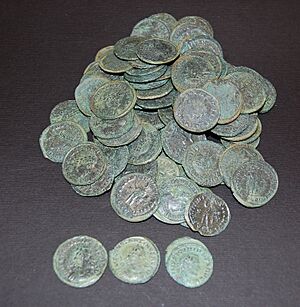Malmesbury Hoard facts for kids
Quick facts for kids Malmesbury Hoard |
|
|---|---|

A portion of the coins from the hoard.
|
|
| Material | Roman coins Roman pottery |
| Size | 1,266 coins |
| Created | 296–317 |
| Period/culture | Romano-British |
| Discovered | 2012 Malmesbury, Wiltshire, England |
| Present location | Athelstan Museum, Malmesbury |
The Malmesbury Hoard is a special collection of Roman coins. It was found near Malmesbury, Wiltshire, England, in 2012. This amazing discovery helps us learn more about the Romano-British period. The term "hoard" means a hidden collection of valuable items.
Contents
Finding the Treasure
How it was Found
In September 2012, a person using a metal detector made an exciting discovery. They found the coins buried together with a ceramic pot. This happened near the town of Malmesbury.
What was Inside
The Malmesbury Hoard contained 1,266 coins in total. Most of these coins, 1,263 of them, were a type called nummi. These were common Roman coins. The other three coins were a different type known as radiates.
All the coins in the hoard were made between the years AD 286 and 317. The three radiate coins featured the faces of Roman Emperors. These emperors were Diocletian, Maximianus, and Allectus.
Where the Coins Came From
The many nummi coins were made in at least eight different Roman cities. Most of them came from three main places:
This shows how far Roman coins traveled across their empire.
Displaying the Hoard
A New Home
The Malmesbury Hoard was bought by the Athelstan Museum in Malmesbury. A special grant from the Heritage Lottery Fund helped the museum buy the coins. This fund helps protect important historical items.
Seeing the Coins Today
The museum put the Malmesbury Hoard on public display in April 2022. Now, visitors can see this ancient treasure up close. It helps people understand what life was like in Roman Britain.

